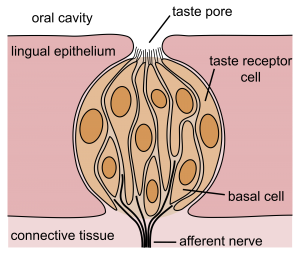This post is also available in Dutch.
You use your tongue to taste sweet, sour, salty and bitter flavors. A few years ago ‘umami’ was added to this list, a kind of ‘savory’ flavor. Why are we able to perceive flavors? And how is does your tongue do it?
Why do we taste?
Our tongue maps the chemical palette of our food. This allows us to taste what our food is made of. Is the food nutritious? Then we’ll taste a lot of sweet and savory flavors. Could this food be bad for us? In that case bitterness is important. Bitter flavors are a last warning that the food you’re putting in your mouth might be poisonous. This way, taste helps us to eat nutritiously and safely.
How do we taste?
Our tongue contains thousands of taste buds. These are small dimples in your tongue that contain a large number of taste cells clustered together. Every taste bud contains 50 to 100 taste cells. Each of these cells is sensitive to a specific flavor and has special receptors to perceive this flavor.
 Image by NEUROtiker [CC-BY-SA-2.5], via Wikimedia Commons
Image by NEUROtiker [CC-BY-SA-2.5], via Wikimedia Commons
The flavors
The salty and sour tasting cells respond to ‘salt’ (sodium ions) and ‘sour’ particles (hydrogen ions). The salt and sour ions enter the cell through special channels, which causes it to activate and start sending signals to the brain. Stronger salty or sour flavors mean more molecules entering, resulting in the cell sending stronger signals.
Sweet is a bit more complicated because, unlike salt and sour ions, sugar does not consist of small particles. The cellular walls of sweet-tasting cells contain large molecules that are able to bind with the typical shape of a sugar molecule. Because these receptors are looking for a specific shape, molecules that resemble the shape of sugar molecules are also able to bind with these receptors. As a result, sweeteners (which are similar in shape to sugar molecules) also taste sweet.
Tasting umami works similar to tasting sweet, but the receptors in this case bind to a different shape: amino acids. Amino acids are important building blocks of the body. For example, DNA is made out of amino acids. A lot of neurotransmitters are also made of amino acids. The most well-known ones are glutamate and tyrosine.
Finally, bitter. I saved this flavor for last, because it is very important. Bitter-tasting cells are full of a variety of different receptors that can recognize a wide range of molecules. Evolution has taught us that these molecules can be poisonous and dangerous. This is why coffee tastes bitter. That is, caffeine is a biologically active substance that can be harmful in high doses. The bitter taste warns us that something might be wrong. This is why children often think coffee is gross.
However, it is possible to get used to bitter if you regularly taste it in combination with other flavors and nothing bad happens. That way your body learns that a specific flavor combination is probably safe after all. You get used to the flavor and can even learn to like it, meaning I can now enjoy a nice cup of coffee.
More information:
Do you also want to know why peppers taste ‘hot?’ Read this blog about hot peppers!
